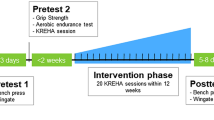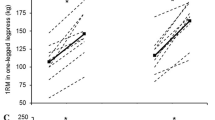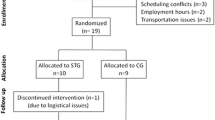Abstract
The freely chosen pedal rate is relatively high and energetically inefficient during submaximal cycling, which is a paradox since the rate of energy expenditure is considered important for voluntary motor behavior in other cyclical activities as, e.g., running. For example, it has been suggested that subjects pedal fast to reduce the perception of force. In this study, we investigated the hypothesis that strength training would cause subjects to pedal at a slower rate during low to moderate submaximal cycling. Fourteen healthy subjects performed supervised heavy (2–12 RM) strength training 4 days/week for 12 weeks, including 2 days/week with leg-extensor and knee-flexor exercises. Seven healthy subjects formed the control group. The training group increased strength (one repetition maximum, 1 RM) in both squat [20%(3), mean (SEM)] and leg curl [12%(1)] exercises from the beginning to the end of the study period (p < 0.01). At the same time, freely chosen pedal rate was reduced by 8 (2) and 10 (2) rpm, respectively, during cycling at 37 and 57% of maximal power output (W max) (p < 0.01). In addition, rate of energy expenditure is 3% (2) lower at 37% of W max (p < 0.05) and tended to be lower at 57% W max (p = 0.07) at the end of the study. Values for strength, freely chosen pedal rate, and rate of energy expenditure, were unchanged for the control group from the beginning to the end of the study. In conclusion, strength training caused subjects to choose a ∼9 rpm lower pedal rate during submaximal cycling. This was accompanied by a ∼3% lower rate of energy expenditure.



Similar content being viewed by others
References
Aagaard P, Simonsen EB, Andersen JL, Magnusson SP, Halkjær-Kristensen J, Dyhre-Poulsen P (2000) Neural inhibition during maximal eccentric and concentric quadriceps contraction: effects of resistance training. J Appl Physiol 89:2249–2257
Almåsbakk B, Whiting HTA, van den Tillaar R (2000) Optimisation in the learning of cyclical actions. In: Sparrow WA (ed) Energetics of human activity. Human Kinetics, Leeds, pp 228–254
Bawa P (2002) Neural control of motor output: can training change it? Exerc Sport Sci Rev 30:59–63
Böning D, Gönen Y, Maassen N (1984) Relationship between work load, pedal frequency, and physical fitness. Int J Sports Med 5:92–97
Borg G (1970) Perceived exertion as an indicator of somatic stress. Scand J Rehabil Med 2:92–98
Carroll TJ, Riek S, Carson RG (2001) Neural adaptations to resistance training: implications for movement control. Sports Med 31:829–840
Coyle EF, Sidossis LS, Horowitz JF, Beltz JD (1992) Cycling efficiency is related to the percentage of type I muscle fibers. Med Sci Sports Exerc 24:782–788
Fleck SJ, Kraemer WJ (2004) Designing resistance training programs. Human Kinetics, Campaign, pp 13–51
Foss Ø, Hallén J (2004) The most economical cadence increases with increasing workload. Eur J Appl Physiol 92:443–451
Foss Ø, Hallén J (2005) Cadence and performance in elite cyclists. Eur J Appl Physiol 93:453–462
Gabriel DA, Kamen G, Frost G (2006) Neural adaptations to resistive exercise: mechanisms and recommendations for training practices. Sports Med 36:133–149
Hadders-Algra M, Brogren E, Forssberg H (1996) Training affects the development of postural adjustments in sitting infants. J Physiol 493:289–298
Hansen EA, Andersen JL, Nielsen JS, Sjøgaard G (2002) Muscle fibre type, efficiency, and mechanical optima affect freely chosen pedal rate during cycling. Acta Physiol Scand 176:185–194
Hansen EA, Jensen K, Pedersen PK (2006) Performance following prolonged sub-maximal cycling at optimal versus freely chosen pedal rate. Eur J Appl Physiol 98:227–233
Klausen K, Rasmussen B, Glensgaard LK, Jensen OV (1985) Work efficiency of children during submaximal bicycle exercise. In: Binkhorst RA et al. (ed) Children and exercise XI. Human Kinetics, Campaign, pp 210–217
Kohler G, Boutellier U (2005) The generalized force–velocity relationship explains why the preferred pedaling rate of cyclists exceeds the most efficient one. Eur J Appl Physiol 94:188–195
Kubo K, Kanehisa H, Fukunaga T (2002) Effects of resistance and stretching training programmes on the viscoelastic properties of human tendon structures in vivo. J Physiol 538:219–226
Löllgen H, Graham T, Sjogaard G (1980) Muscle metabolites, force, and perceived exertion bicycling at varying pedal rates. Med Sci Sports Exerc 12:345–351
Loveless DJ, Weber CL, Haseler LJ, Schneider DA (2005) Maximal leg-strength training improves cycling economy in previously untrained men. Med Sci Sports Exerc 37:1231–1236
Lucia A, Hoyos J, Perez M, Santalla A, Earnest CP, Chicharro JL (2004) Which laboratory variable is related with time trial performance time in the Tour de France? Br J Sports Med 38:636–640
Lusk G (1976) The elements of the science of nutrition. Johnson Reprint Corporation, New York, p 65
Marsh AP, Martin PE (1997) Effect of cycling experience, aerobic power, and power output on preferred and most economical cycling cadences. Med Sci Sports Exerc 29:1225–1232
Martin PE, Sanderson DJ, Umberger BR (2000) Factors affecting preferred rates of movement in cyclic activities. In: Zatsiorsky VM (ed) Biomechanics in sport. Performance enhancement and injury prevention. Blackwell Science, London, pp 143–160
Mihevic PM (1981) Sensory cues for perceived exertion: a review. Med Sci Sports Exerc 13:150–163
Mogensen M, Bagger M, Pedersen PK, Fernström M, Sahlin K (2006) Cycling efficiency in humans is related to low UCP3 content and to type I fibres but not to mitochondrial efficiency. J Physiol 571:669–681
Nielsen JS, Hansen EA, Sjøgaard G (2004) Pedalling rate affects endurance performance during high-intensity cycling. Eur J Appl Physiol 92:114–120
Sparrow WA, Newell KM (1998) Metabolic energy expenditure and the regulation of movement economy. Psychon Bull Rev 5:173–196
Stegemann J, Ulmer H-V, Heinrich KW (1968) Relation between force and force perception as basis for the selection of energetically unfavorable pedaling frequencies in cycling. Int Z Angew Physiol 25:224–234
Takaishi T, Yamamoto T, Ono T, Ito T, Moritani T (1998) Neuromuscular, metabolic, and kinetic adaptations for skilled pedaling performance in cyclists. Med Sci Sports Exerc 30:442–449
Zehr EP (2005) Neural control of rhythmic human movement: The common core hypothesis. Exerc Sport Sci Rev 33:54–60
Acknowledgments
Therese Fostervold and Øyvind Hansen for their assistance with training and testing.
Author information
Authors and Affiliations
Corresponding author
Rights and permissions
About this article
Cite this article
Hansen, E.A., Raastad, T. & Hallén, J. Strength training reduces freely chosen pedal rate during submaximal cycling. Eur J Appl Physiol 101, 419–426 (2007). https://doi.org/10.1007/s00421-007-0515-7
Accepted:
Published:
Issue Date:
DOI: https://doi.org/10.1007/s00421-007-0515-7




